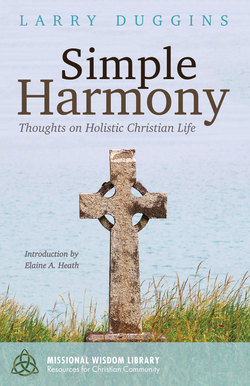Читать книгу Simple Harmony - Larry Duggins - Страница 15
На сайте Литреса книга снята с продажи.
ОглавлениеThe first of the three anchor passages is often referred to as the “Greatest Commandment.” In the passage, Jesus is involved in an extended conversation with a group of priests, Pharisees, and Sadducees who have confronted him regarding his authority. Earlier in the day, as reported in Matthew 21, Jesus had entered the temple and driven out the vendors and had overturned the money-changing tables. The temple’s figures of authority confronted Jesus, questioning him about his behavior and about his authority to act as he did. The exchange takes place during the climactic week of Jesus’ ministry, which culminated with the death and resurrection.
Matthew 22:23 identifies the people who questioned Jesus as the chief priests and elders of the people. Later in the chapter, we learn that those elders included Pharisees and Sadducees, who were members of religious factions that interpreted Torah differently. According to the New Interpreter’s Dictionary of the Bible (Abingdon Press, 2009), the Pharisees were more aligned with the common people and thought of themselves as upholding the traditions of Moses, while the Sadducees tended to be more aristocratic and were more closely tied to the priestly traditions. It was quite common for the two groups to debate interpretation with one another, and it would have been expected that elders of both traditions would participate in the temple leadership.
The temple’s figures of authority challenged Jesus with a direct question regarding his authority, but Jesus invoked his status as a rabbi to answer their question with a question. When the temple authorities could not answer Jesus’ query to them, Jesus then invoked his right not to answer them directly. Instead, he took the opportunity to teach three parables that describe the ministry of John the Baptist, the ministry of Jesus. and the coming of the kingdom of God, all of which reflected poorly on the temple authorities.
The Pharisees and Sadducees then asked Jesus a series of questions that seem to be intended to entrap Jesus in an anti-government or blasphemous position so that his words might be used against him. The resulting questions and answers include important teachings on taxation, resurrection, and the identity of the Messiah, and they also include Jesus’ pivotal statement on the nature of the vocation of humanity—to love God with all the heart, soul, and mind, and to love others as oneself.
The response of Jesus was grounded in Torah. His response begins with the first of the Ten Commandments as related in Deuteronomy 6:5. The commandment to love God completely with one’s entire being was especially familiar to the Pharisees, who included this passage in the phylacteries worn on their bodies. A phylactery is a set of pouches with straps that would be filled with scripture and then strapped to the forehead and arms. The commandment to love others is found in Leviticus 19:18 in the midst of a teaching on just and moral behavior. Jesus the rabbi places the two commandments in relationship with one another in a way that allows them to amplify one another.
In the Greatest Commandment as it is presented in Matthew, Jesus Christ presents a very clear statement detailing precisely how people are to order their lives and spend their time. By their very definition, commandments are directives—not suggestions, not options, not possibilities, but imperative statements of that which is to be done. Jesus begins by giving God priority and by saying that we are to love God with our entire being, using all the gifts of our heart, mind, and soul. He then equates a second commandment to the first, instructing us to love our neighbor as we love ourself. Jesus concludes his response with a remarkable statement that sharpens our reaction—he concludes that all of the Law and the Prophets are based on these two commands, that this is what we are to focus on in the world.
The Greatest Commandment becomes an even more powerful statement in the context of Matthew 23, which immediately follows it. In that chapter, Jesus levels a series of scathing accusations against the scribes and Pharisees in some of the strongest language attributed to him in the Gospels. Jesus condemns the practice of emphasizing form over substance—of focusing on rule keeping rather than justice. He accuses the leaders of completely missing the point of God’s teachings by focusing on compliance to minutia and caring about outward appearances rather than dedicating themselves to love. When read in sequence, it seems very clear that Jesus says that loving God and loving others is the most important duty a person can have, and that to emphasize anything else leads to woe.
Variations on the Greatest Commandment appear in all four Gospels. In the variation found in Mark 12:28–34, the context remains an inquiry into the authority of Jesus by the temple hierarchy, but with some interesting differences. In Mark, the questioner is a scribe, not a Pharisee, and Mark describes the motivation for the question as true curiosity driven by a respect for Jesus’ responses to the questions of others. The scribe affirms the response of Jesus by quoting supporting scripture, and Jesus responds favorably to the wisdom of the scribe by commenting that “you are not far from the kingdom of God” in 12:34. The less adversarial exchange between Jesus and the scribe allows space for Jesus to associate the love of God and neighbor with the coming of the kingdom.
